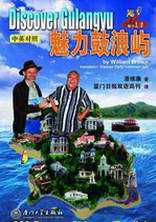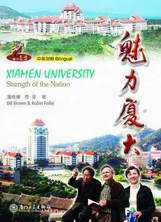![]() Click
to
Access
Click
to
Access
OUTSIDE China
![]() Click
to Access
Click
to Access
INSIDE
China ![]()
TRAVEL LINKS
![]() Xiamen
Xiamen
![]() Gulangyu
Gulangyu
![]() Jimei
Jimei
![]() Tong'an
Tong'an
![]() Jinmen
Jinmen
![]() Zhangzhou
Zhangzhou
![]() Quanzhou
Quanzhou
![]() Wuyi
Wuyi
![]() #1Fujian
Sites!
#1Fujian
Sites!
![]() Fujian
Foto Album
Fujian
Foto Album
![]() Books
on Fujian
Books
on Fujian
![]() Readers'Letters
Readers'Letters
![]() Ningde
Ningde
![]() Zhouning
Zhouning
![]() Longyan
Longyan
![]() Sanming
Sanming
![]() Putian
Putian
![]() Bridges
Bridges
![]() Travel
Info,
Travel
Info,
![]() Hakka
Roundhouses
Hakka
Roundhouses
![]() Travel
Agents
Travel
Agents
MISC. LINKS
![]() Amoy
People!
Amoy
People! ![]()
![]() Darwin
Driving
Darwin
Driving ![]()
![]() Amoy
Tigers
Amoy
Tigers
![]() Chinese
Inventions
Chinese
Inventions
![]() Tibet
in 80 Days!
Tibet
in 80 Days!![]()
![]() Dethroned!
Dethroned!
![]()
![]() Misc.Writings
Misc.Writings
![]() Latest
News
Latest
News
![]() Lord
of Opium
Lord
of Opium
![]() Back
to Main Page
Back
to Main Page
![]() Order
Books
Order
Books![]() Xiamenguide
Forum
Xiamenguide
Forum 


Click for Zhouning (Carp
Worshippers)
Sandu’ao Island has been
open to outside trade since the Tang Dynasty, but because of its proximity
to Taiwan, and the presence of the People’s Navy, it is now off
limits to us foreign devils. So it was a treat to be given a tour of the
island and the “fishing villages on the sea.”
East of Feiluan fishing village we paid 230 yuan (a full month’s
wages for locals) for a roundtrip ticket to Sandu’ao on a small
boat with a Yamaha 150 outboard motor. The placid bay was so vast it appeared
to be open ocean. Almost entirely landlocked, it is the world’s
deepest ice-free harbor. It also gets deeper as the years pass--rather
like America’s national debt.
 911
or 119? The floating fishing villages’ inhabitants
need never set foot on land. They have their own floating restaurants
and stores, and their own emergency phone numbers. (In China, of course,
911 is dialed 119, and 411 is dialed 114. It’s probably the principle
of the thing).
911
or 119? The floating fishing villages’ inhabitants
need never set foot on land. They have their own floating restaurants
and stores, and their own emergency phone numbers. (In China, of course,
911 is dialed 119, and 411 is dialed 114. It’s probably the principle
of the thing).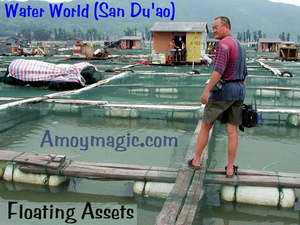
I marveled that the villages stayed afloat. They seemed little more than
wood and tarpaper shacks on bamboo and wire frames fastened to Styrofoam.
Lots of floating assets here (good liquidity, I imagine).
Long Arm
Fortunately, nary a typh oon
was in site as we plowed across placid waters to DouMao Island, which
is named after a rock resembling an ancient Chinese magistrate’s
hat. The big attraction, besides the rock that resembles a giant peach
(it was the pits) was a boulder with a hole in it. Tourists stand on one
side while someone hidden within sticks their arm out the small hole,
making it appear they have a longer arm than the law.
oon
was in site as we plowed across placid waters to DouMao Island, which
is named after a rock resembling an ancient Chinese magistrate’s
hat. The big attraction, besides the rock that resembles a giant peach
(it was the pits) was a boulder with a hole in it. Tourists stand on one
side while someone hidden within sticks their arm out the small hole,
making it appear they have a longer arm than the law.
A colorful character in preliberation era military fatigues and a bamboo
hat waved a sickle at us and demanded money, but a wizened little granny
lugging a basket of mineral water bottles ran him off. “He’s
a little off,” my rescuer said. “And the sickle’s dull.”
Spanish
Catholic Church  Eventually
my guide helped me escape the endless rounds of “Ganbei!”
(Dry Glass!) and led me to the Catholic church and the old American nunnery,
two of the few structures that survived the Japanese’ bombing in
the 1930s. Sanduo never quite recovered. The island had 30,000 people
in the 1940s, but only 20,000 today, and life’s not easy. One couple
on main street (the only street) was stuffing beizis (Chinese blankets)
with the lining picked out of soiled jackets that had probably been recycled
from the Long March or the Short April. For this couple’s sake,
I hope Ningde achieves its ambitious goals.
Eventually
my guide helped me escape the endless rounds of “Ganbei!”
(Dry Glass!) and led me to the Catholic church and the old American nunnery,
two of the few structures that survived the Japanese’ bombing in
the 1930s. Sanduo never quite recovered. The island had 30,000 people
in the 1940s, but only 20,000 today, and life’s not easy. One couple
on main street (the only street) was stuffing beizis (Chinese blankets)
with the lining picked out of soiled jackets that had probably been recycled
from the Long March or the Short April. For this couple’s sake,
I hope Ningde achieves its ambitious goals.
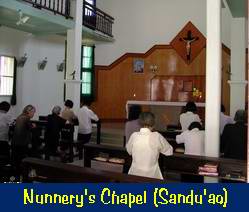
The Spanish style stone church has a rectory on the left and an old chapel.
The American nunnery behind the church is now the “Tianlao Yuan”
(Heaven’s Garden for the Elderly). An ancient nun gave us a tour
of the rooms and the courtyard, which had a marble fountain (dry), tired
shrubs, and pots of dusty flowers.
A small chapel to the left had a large crucifix
in front, and the side walls had ten scenes from 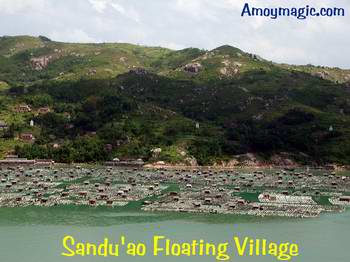 Christ’s
life, with crosses above each of them. A dozen elderly ladies and a couple
of girls chanted prayers that reminded me somewhat of Buddhist chants.
Maybe Catholics will someday develop their own versions of the electronic
Buddhist chant boxes found in Chinese restaurants, stores and homes.
Christ’s
life, with crosses above each of them. A dozen elderly ladies and a couple
of girls chanted prayers that reminded me somewhat of Buddhist chants.
Maybe Catholics will someday develop their own versions of the electronic
Buddhist chant boxes found in Chinese restaurants, stores and homes.
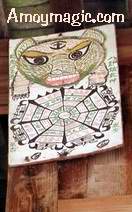 When
I asked to take photographs, the nun asked, “Are you Catholic?”
When
I asked to take photographs, the nun asked, “Are you Catholic?”
“I’m Christian,” I hedged.
She chewed on this, then said, “We’ll make an exception this
time.”
As I snapped a couple of quick shots, heads shot up as if the supplicants
had seen the glory of heaven flash before them.
We retraced our steps to the village below, where I heard
dozens of women chanting in a newly tiled three-story home. Catholics,
I was told, gather in many homes throughout the day to pray, and no wonder—there
is plenty of competition. Just across the street a hand drawn Taoist 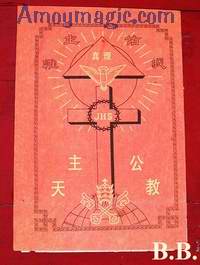 symbol
was pasted above the wooden door. It had the traditional 8 points, with
some creature in the middle. I was told it was either a dog, cat, lion
or unicorn. (And probably edible.) But the Catholics were not to be outdone.
They pasted paper crosses on the lintels, and Pope John Paul II posters
in the courtyards.
symbol
was pasted above the wooden door. It had the traditional 8 points, with
some creature in the middle. I was told it was either a dog, cat, lion
or unicorn. (And probably edible.) But the Catholics were not to be outdone.
They pasted paper crosses on the lintels, and Pope John Paul II posters
in the courtyards.
My Buddhist guide said she also worships Taoist gods when its more convenient.
And she confided that she was of the She minority,
“But I don’t wear traditional clothes,” she explained.
“One set costs 300 to 400 Yuan. And it takes hours to put up my
hair.”
Foreign Devils and
Chinese Devils A shopkeeper yelled, “Look, a foreign devil!”
“How are you, Chinese devil!” I said. It usually gets a laugh—but
not this time.
“There are no Chinese devils! You foreigners did the evil, not us!”
I was stunned. Chinese rarely come on this way. But I was hot and tired,
and I retorted, though calmly, “Which evil? We’ve done many.”
The man was taken aback. He said, “The opium wars, the burning of
the Summer Palace, the--”
“—All evil, I admit,” I interrupted. “But they
were 150 years ago. Neither I nor my immediate ancestors were involved.
Should I curse your generation for the Cultural Revolution? That was quite
devilish too!”
The man gaped at me, mouth opening and closing like a doomed carp facing
a Cantonese chef’s cleaver, and I regretted my smart mouth. Chinese
rarely come on that way to foreigners, and I’d have done well to
heed Proverbs’ advice, “A soft answer turns away wrath. ”
Yet even as I remonstrated myself, the man smiled and said, “I never
thought of it that way.” I heaved a sigh of relief. He invited me
in for tea, we had a good chat, and I ended the day one friend richer.
We all have so much to learn. Chinese and foreigners alike would be a
lot better off if we abandoned our tenacious stereotypes and generalizations,
which are more contagious than mumps or chicken pox—and sometimes
just as fatal. I’ve gradually learned that all generalizations are
false.
Except for the one I just made.
Click here for Xiapu
(Japanese Holy Land!)
TRAVEL
LINKS  Favorite
Fujian Sites
Favorite
Fujian Sites  Fujian
Foto Album
Fujian
Foto Album  Xiamen
Xiamen
 Gulangyu
Gulangyu
 Fujian
Guides
Fujian
Guides  Quanzhou
Quanzhou
 Zhangzhou
Zhangzhou
 Longyan
Longyan
 Wuyi
Mtn
Wuyi
Mtn  Ningde
Ningde
 Putian
Putian
 Sanming
Sanming
 Zhouning
Zhouning
 Taimu
Mtn.
Taimu
Mtn.  Roundhouses
Roundhouses
 Bridges
Bridges
 Jiangxi
Jiangxi
 Guilin
Guilin
 Order
Books
Order
Books
 Readers'
Letters
Readers'
Letters
Last Updated: May 2007
![]()
DAILY
LINKS
![]() FAQs
Questions?
FAQs
Questions?
![]() Real
Estate
Real
Estate
![]() Shopping
Shopping
![]() Maps
Maps
![]() Bookstores
Bookstores
![]() Trains
Trains
![]() Busses
Busses
![]() Car
Rental
Car
Rental
![]() Hotels
Hotels
![]() News
(CT)
News
(CT)
![]() Medical
& Dental
Medical
& Dental
![]() YMCA
Volunteer!
YMCA
Volunteer! ![]()
![]() XICF
Fellowship
XICF
Fellowship
![]() Churches
Churches
![]()
![]()
![]() Temples
Temples![]()
![]() Mosque
Mosque
![]() Expat
Groups
Expat
Groups
![]() Maids
Maids
![]() Phone
#s
Phone
#s
EDUCATION
![]() Xiamen
University
Xiamen
University
![]() XIS(Int'l
School)
XIS(Int'l
School)
![]() Study
Mandarin
Study
Mandarin
![]() CSP(China
Studies)
CSP(China
Studies)
![]() Library
Library
![]() Museums
Museums
![]() History
History
DINING
![]() Restaurants
Restaurants
![]() Asian
Asian
![]() Veggie
Veggie
![]() Junk
Food
Junk
Food
![]() Chinese
Chinese
![]() Italian
Italian
![]() International
International![]()
![]() Visas
4 aliens
Visas
4 aliens
RECREATION
![]() Massage!
Massage!
![]() Beaches
Beaches
![]() Fly
Kites
Fly
Kites
![]() Sports
Sports
![]() Boardwalk
Boardwalk
![]() Parks
Parks
![]() Pets
Pets
![]() Birdwatching
Birdwatching
![]() Kung
Fu
Kung
Fu ![]() Hiking
Hiking
![]() Music
Events
Music
Events
![]() Festival&Culture
Festival&Culture
![]() Humor&
Humor&![]() Fun
Fotos
Fun
Fotos![]()
BUSINESS
![]() Doing
Business
Doing
Business
![]() Jobs!(teach/work)
Jobs!(teach/work)
![]() Hire
Workers
Hire
Workers
![]() Foreign
Companies
Foreign
Companies
![]() CIFIT
(Trade Fair)
CIFIT
(Trade Fair)
![]() MTS(Translation)
MTS(Translation)
![]()
Back to Top
